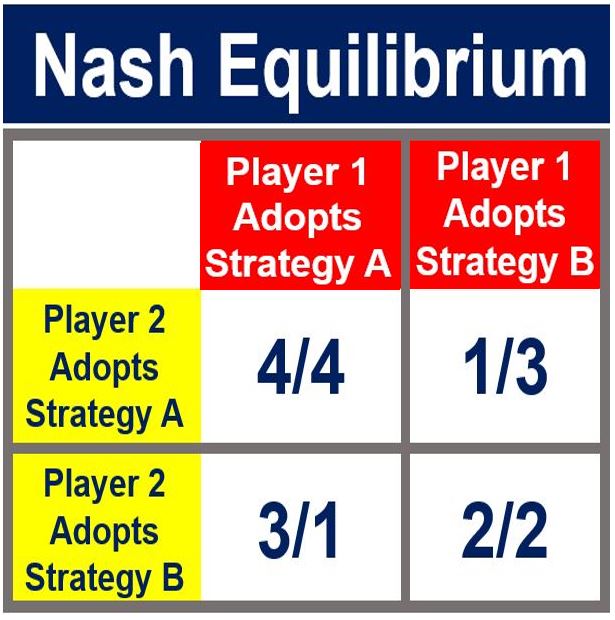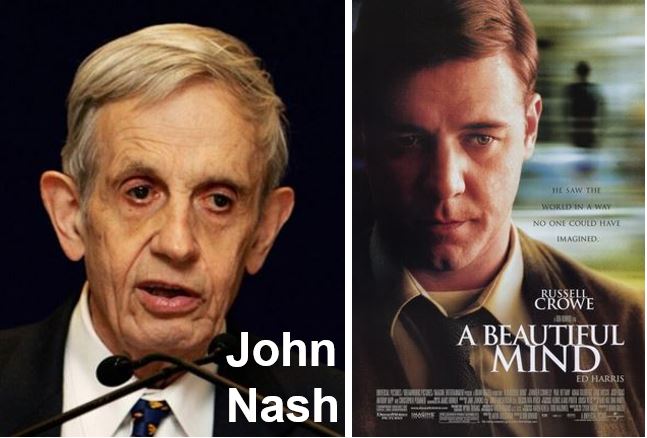Nash equilibrium occurs when each player is seeking his or her best possible strategy, while fully aware of the strategies that everybody else is pursuing. It is a key concept in **game theory. As soon as the Nash equilibrium is reached, there is no reason for anybody to consider changing their strategy. The Nash equilibrium is named after John Forbes Nash Jr. (1928-2015), an American mathematician who shared the 1994 Nobel Memorial Prize in Economic Sciences with two other game theorists.
** Game theory is the study of how humans make decisions of strategy in situations – the formal study of cooperation and conflict.
According to the Economist’s glossary of economic and business terms, to define the Nash equilibrium is as follows:
“An important concept in game theory, a Nash equilibrium occurs when each player is pursuing their best possible strategy in the full knowledge of the strategies of all other players.”
“Once a Nash equilibrium is reached, nobody has any incentive to change their strategy. It is named after John Nash, a mathematician and Nobel prize-winning economist.”
 The Coordination Game – a classic, two player, two-strategy game. Players 1 & 2 should coordinate by adopting Strategy A, to receive the highest payoff – 4/4. If they both choose Strategy B, however, there is still a Nash equilibrium. Even though 2/2 is less than 4/4, they both opt for Strategy B and have no incentive to change that strategy because it prevents them from getting a 1.
The Coordination Game – a classic, two player, two-strategy game. Players 1 & 2 should coordinate by adopting Strategy A, to receive the highest payoff – 4/4. If they both choose Strategy B, however, there is still a Nash equilibrium. Even though 2/2 is less than 4/4, they both opt for Strategy B and have no incentive to change that strategy because it prevents them from getting a 1.
When a Nash equilibrium exists, none of the players has anything to gain by changing only his or her own strategy. In this state, each player has chosen a strategy, none of them can benefit by changing their own strategies while nobody else alters theirs.
The Nash theory can be tested in real situations using experimental economic methods.
The Nash theory helps economists determine how competing companies set their prices, and how auctions should be set up by governments so that they can squeeze the most from bidders. It is also used to work out why groups sometimes make self-defeating decisions.
Nash theory – the Prisoners’ Dilemma
The Prisoners’ Dilemma is commonly used to explain how we make decisions. Imagine there are two prisoners, each one alone in his prison cell – they cannot communicate or pass messages to each other.
 The Nash equilibrium was named after John F. Nash Jr. (1928-2015), an American mathematician considered by many of his peers as a genius. In 1959, he was admitted to McLean Hospital and diagnosed with paranoid schizophrenia. Russell Crowe played Nash in the biographical movie ‘A Beautiful Mind’, which was inspired by a 1998 book of the same name by Sylvia Nasar. The film won four Academy Awards for Best Director, Best Supporting Actress, Best Adapted Screenplay, and Best Picture. (Images: John Nash – biography.com. A Beautiful Mind – Wikipedia)
The Nash equilibrium was named after John F. Nash Jr. (1928-2015), an American mathematician considered by many of his peers as a genius. In 1959, he was admitted to McLean Hospital and diagnosed with paranoid schizophrenia. Russell Crowe played Nash in the biographical movie ‘A Beautiful Mind’, which was inspired by a 1998 book of the same name by Sylvia Nasar. The film won four Academy Awards for Best Director, Best Supporting Actress, Best Adapted Screenplay, and Best Picture. (Images: John Nash – biography.com. A Beautiful Mind – Wikipedia)
The public prosecutor gives the prisoners the following choices:
– If they both betray each other about the murder, they will probably get 5 years in prison each.
– If A betrays B, while B remains quiet, then B will go to prison for 20 years, while A will be set free. If A remains quiet and B betrays him, A will go to prison for 20 years and B will be set free.
– If they both keep quiet, they will face just one year each in prison.
If they had the opportunity to talk to each other, the best strategy would be to keep quiet – nobody would serve a long stretch that way.
However, an economist who supports the concept of the Nash equilibrium would determine that they would both chose to betray each other.
The Nash equilibrium – self-interest rules
Every member of a group makes the best decision for himself or herself – so the Nash equilibrium concept shows – based on how they think the others will act. Nobody can do better by altering their strategy – every group member is deciding in their own best possible interest, given their choices.
In the Prisoners’ Dilemma situation, remaining silent is never a good idea as far as prisoners A and B are concerned, no matter what the other prisoner does.
Since prisoner A may have pointed the finger at B, by also being a snitch (betrayer) it is a guarantee for B that he won’t do life in prison. And if A remains silent, then betraying him sets B free. Prisoner A also uses the same logic the other way round.
Nash equilibrium in the business world
In the world of business, economists use the Nash equilibrium to determine how commercial rivals respond to each other’s prices. Two giant rivals setting pricing strategies to outcompete each other are likely to squeeze consumers harder than they would if there were hundreds of similarly-sized players in that sector.
Economists can understand – using the Nash equilibrium – how decisions that appear good for the individual, may be disastrous for the group. This terrible outcome for all explains why we over-pollute our atmosphere with carbon dioxide or overfish the oceans.
If only we could agree and showed some restraint, we would all be so much better off!
However, as far as the individual is concerned, gas-guzzling and fishing like crazy makes sense. The concept helps policymakers devise solutions for difficult problems.
Nash equilibrium used by governments
Nash equilibrium experts say they have helped governments raise billions of dollars, pounds and euros. The following quote comes from an article in The Economist:
“In 2000 the British government used their (Nash equilibrium geeks’) help to design a special auction that sold off its 3G mobile-telecoms operating licences for a cool £22.5 billion ($35.4 billion).”
“Their trick was to treat the auction as a game, and tweak the rules so that the best strategy for bidders was to make bullish bids (the winning bidders were less than pleased with the outcome).”
“Today the Nash equilibrium underpins modern microeconomics (though with some refinements). Given that it promises economists the power to pick winners and losers, it is easy to see why.”
Video – Nash equilibrium – Definition and Meaning
In this Khan Academy video, the speaker presents a Prisoners’ Dilemma situation similar to the one in the article above – however, in this case they have been caught red-handed dealing illegal drugs.
